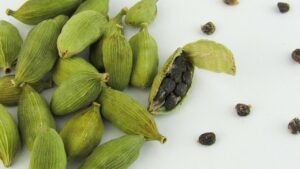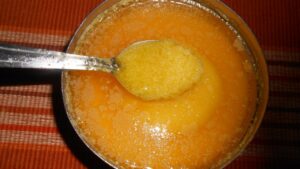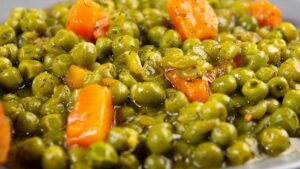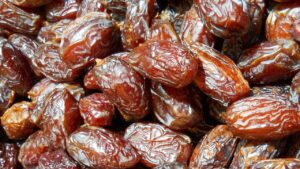Jaggery or Gur is a sweet wonder that can make both deserts and savory dishes a little more blessed with its natural goodness.
This winter, load the most authentic Indian desserts with sweetness of jaggery and bring your childhood nostalgia back in your life.
In Hinduism, jaggery is associated with religious significance. Jaggery-based sweets are offered to deities in auspicious ceremonies.
These are believed to symbolize good news as according to customs, ingredients from the locality should be used during religious ceremonies.
What is Gur (Jaggery)?
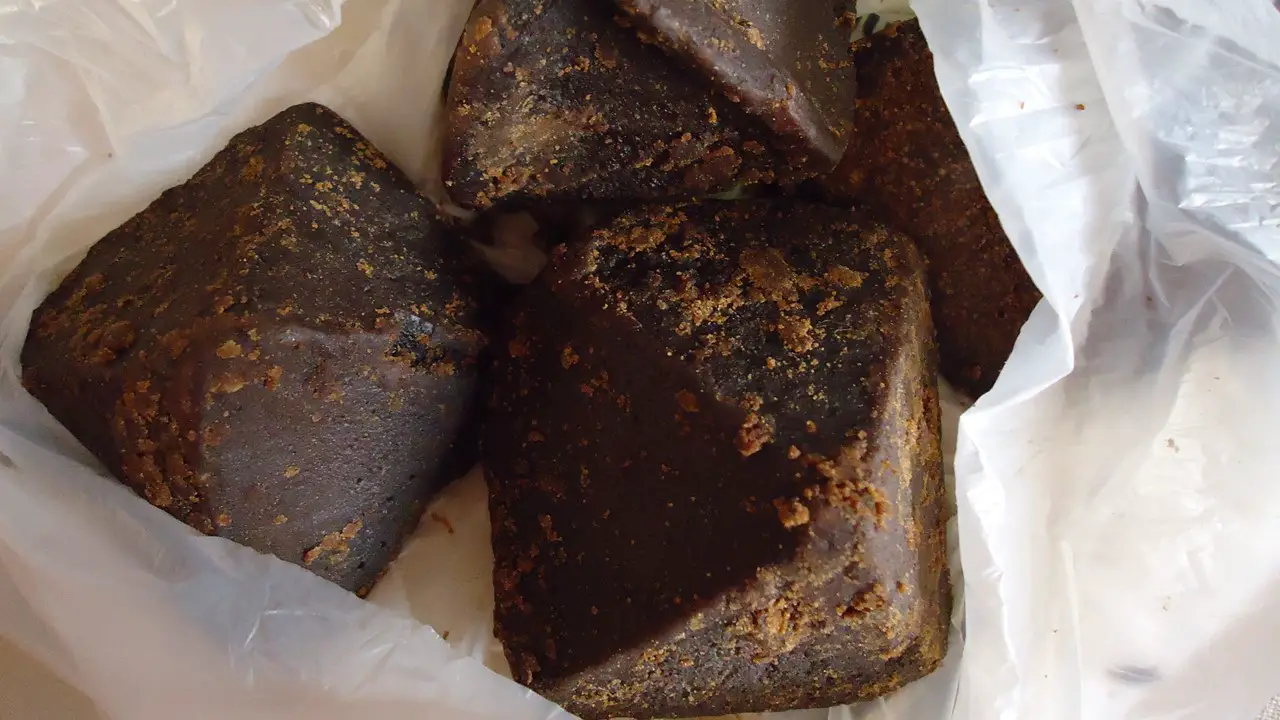
Gur or Jaggery is a type of unrefined cane sugar that is commonly used in South Asian and Southeast Asian cuisines.
It is made by boiling the sap of sugarcane or palm trees until it becomes a thick, dark syrup that is then cooled and solidified.
Gur has a rich, caramel-like flavor and is often used as a sweetener in desserts, drinks, and other dishes.
It is also believed to have some health benefits and is sometimes used in traditional medicine.
Gur is known by different names in different regions, such as jaggery in India and Pakistan, gula melaka in Malaysia, and nam tan peep in Thailand.
Uses of Gur in Indian Cuisines
In India, Gur or jaggery is a much-loved sweetener. It is a natural sweetener that trumps all others and of course, the refined agents like white sugar.
Another unique and great aspect of Gur is it offers a distinct flavor. In almost all sweet delicacies, Gur can work as a better, flavorful and healthy substitute for white sugar.
Gur comes in a variety of textures, depending on its source and the process of making. Hardened jaggery is usually called Gur though in Bengal, jaggery of all textures is known as Gur.
In Bengal, a chunk of Gur deliciously accompanies rotis in breakfast. This tradition is still in vogue in rural Bengal during winter.
And believe me, it tastes awesome. I even love trying paratha and luchi with fur instead of curry and/or rasgulla.
Winter is the perfect season to bring the flavor of Gur to your platter. It is a lot of fun to prepare sweet and savory delicacies with jaggery.
It is good for your health. Jaggery is a rich source of iron and sucrose. Hence, jaggery-made dishes are both delectable and nutritious.
The continental and Chinese thalis are slowly creeping into our daily menu list, replacing our age-old traditions.
It’s unfortunate that many in the gen Y, especially those living in the urban zones, don’t know how traditional dishes ooze both great taste and goodness.
Gur and adarak wali chai! Well, its popularity cuts across the country’s landscape.
Especially when the mercury drops so low that it makes you shiver even under the blanket, tea prepared with jaggery and ginger flakes brings you the much-needed warmth along with blessed flavour.
Khejurer Gur and winter are almost synonymous. In Bengal, people call it ‘Notun Gur’ or “Nolen Gur” (freshly made jaggery).
Notun Gur is heavily used in making a variety of sweets. These days, it replaces sugar in making Rasgulla. Notun Gur blesses sweets with a subtle, amazing flavor that is enough to pamper your taste buds.
Date palm jaggery (Khejurer Gur) is a highly prized produce in winter.
During chilly months, sap is collected from date palm trees and then stirred in a big pan to make gur of three different types – Jhola Gur (semi liquid), Dana Gur (jaggery with grains) and Patali (solid type).
Jaggery is commonly used to make coconut Ladoo. Though Laddoos are also made with white sugar (which are called Chinir Naru), Gurer Naru is most favorite for the Bongs.
Add cardamom powder and khoya, the outcome will be a flavor-some delicacy one of its kind.
Patishapta Or Peethe is a signature Bong dessert, usually prepared in winter. Coconut shreds are cooked with Gur to make pur (stuffing) in Peethe. Every bite brings you the goodness of both coconut and jaggery.
Jaggery is also used in Payesh. It adds both flavour and colour to the dish. However, you should be careful while adding jaggery to milk.
It is best to add gur only when the milk is lukewarm; otherwise it may cause milk to cuddle.
Assam boasts of a similar kind of preparation. One of the most popular sweet dishes from our neighboring state is til-pitha which makes generous use of gur.
People in some villages of Assam use a cube of gur in their salty tea, popularly known as Cheleka-Chah (licking tea).
Why only sweet dishes? Jaggery is also used in savory delicacies as well. Achari chicken is a popular dish blessed with goodness of jaggery and a few selected spices.
In the South, the smoky flavor of jaggery offset the sour taste of tamarind in sambar, which is a popular spicy soup enjoyed with Dosa.
It is also used in Rasam, another signature delicacy from the South Indian kitchens.
Want to make your dal more flavourful? Add some jaggery. It will balance the salty, sour and spicy concoction, particularly in Bengali-style lentils. Jaggery is also a favourite ingredient in both Gujarat and Karnataka cuisines as well.
Jaggery is also added to lentil soups (dāl) to add sweetness to balance the spicy, salty and sour components, particularly in Bengali cuisine, North Karnataka cuisine and Gujarati cuisine.
In Maharashtra, most dals and vegetable curries contain jaggery. Tilgul is a special dessert prepared during Makar Sankranti. A similar preparation, called Tal Sankli or Tal na Ladu, is made in Gujrat.
Puran Poli, a well-known Maharashtrian recipe uses both sugar and jaggery. Gur is used in Chakkarai Pongal (thai pongal), a popular sweet dish in Tamil Nadu.
In Rajasthan, gur ka chawal or jaggery rice is a traditional dish. No prize for guessing what makes the taste so yummy.
This dessert is usually prepared during the festival of Pongal celebrated at the beginning of the harvesting season.
Do you know jaggery is also used in pickles?
Kuler achar (berry pickles), mishit amer achar (sweet mango pickles), tetuler achar (tamarind achar) and there are many more to swear by the flavour of gur.
Jaggery lends sweetness to the tangy pickles, thereby offering a balance of taste. Yes, you can always replace jaggery with sugar but believe me, it will make a “hell and heaven” difference in taste.
I’m now going to share with you some more goodness of gur. So, stay tuned! Many of you have heard of lohri. Til ladoo is a traditional dish prepared during this festival.
It is made with roasted sesame seeds and jaggery, with an additional blessing of flavors coming from saffron.
Gur ki roti made from whole wheat flour and milk-gur mixture, with topping of a dollop of ghee, is delicately and deliciously sweet.
We usually use sugar for making semolina. However, you can use jaggery for a change in flavor and taste.
Semolina halwa with loads of nuts is a perfect delicacy to feel the warmth inside and satisfy your sweet craving too.
Gulgule is an easy-to-prepare recipe. A thick batter is made from wheat flour, jaggery, and ghee. The deep-fried delicacy can bless your taste buds any day.
Khatti Meethi Phaliyan is a mildly sweet and tangy veggie preparation. Tamarind and jaggery lend their goodness to coconut and stir fried beans. If cooked to perfection, the dish will make you fall in love with it.
Atte ka halwa is a popular dish from Punjab. Prepared with wheat flour, jaggery and ghee, this simple sweet delight will give you the warmth of flavor in winter.
Peanut chikki, is an epitome of sweet love brewing between peanuts and jaggery. It is a perfect anytime-you-can-gorge-on snack. It supplies your body with necessary nutrition and also keeps you warm.
Amchoor ki launji is a sweet-sour sidekick. You will love the flavor with every bite! It is prepared with dry mango powder, jaggery and a few selected spices.
Carrots and chana dal cooked with coconut, tamarind, jaggery and curry leaves to make the yummiest carrot gojju.
How Does Gur Taste?
Gur has a distinctive taste that is sweet, rich, and earthy, with a hint of caramel and molasses.
The flavor is often described as complex and nuanced, with subtle notes of spices such as cinnamon and ginger.
The texture of gur is soft and sticky, similar to toffee or caramel, and it can be chewy or crumbly depending on how it’s made and stored.
Overall, gur has a delicious, natural sweetness that makes it a popular ingredient in many Indian sweets and desserts.
How Do You Know If Your Gur is Pure?
Gur is obtained from sugarcane, dates, palmyra palm etc are having distinct colour and taste of its own.
But the process of making it in a pure form without any sort of adulteration remains the same.
When you are buying the Gur then you must check the colour, taste and see whether you find any sort of crystals that are added to it.
If you feel that all these traits are obtained in perfect shape then you can certainly say the Gur is definitely pure.
What is the Difference Between Gur and Jaggery?
Gur and Jaggery are both the same and these are obtained in Asia & Africa.
Both of these products are obtained from sugarcane juices or palmyra palm.
These are then boiled to prepare the solid form that is best known as Gur or Jaggery.
How is Gur Prepared?
Sugarcane juice which is an opaque liquid that is obtained or extracted.
It comes in light yellow to dark green liquid depending on the sugar cane colour.
There are several soluble impurities found in sugar cane juices like wax, mud, etc. these are all cleaned to maintain the high quality.
But to preserve and sell, a special procedure is being maintained in the manufacturing process.
Where extraction, cleaning and then drying is done with mechanical processes.
Questions & Answers:
Why Baking Soda is Used in Gur?
Baking soda is used in Gur to look whiter. In fact, if the Gur looks excessive white then you must understand that excess sodium bicarbonate is being added to it.
Is It OK to Keep Gur in the Fridge?
Yes, you can store the Gur in a fridge just make sure you are having a steel box rather than a plastic one to make it perfect.
Can We Put Gur in Coffee?
Yes, you can simply put Gur in the coffee as it gives you better taste than sugar.
Can You Mix Gur with Turmeric Milk?
Yes, you can definitely add Gur with Turmeric milk. It actually activates the goodness of the milk to a large extent.
What is Gur Called in Different Languages?
Gur is known as Jaggery in English and Gur in Hindi.
Conclusion
Jaggery or Gur is a natural and healthy sweetener that is commonly used in South Asian and Southeast Asian cuisines.
It is a popular ingredient in traditional Indian desserts and is associated with religious significance in Hinduism.
Jaggery has a rich, caramel-like flavor and is also used in savory dishes.
Winter is the perfect season to use jaggery and explore traditional Indian delicacies.
Gur is also a source of iron and sucrose, making it both nutritious and delicious.

